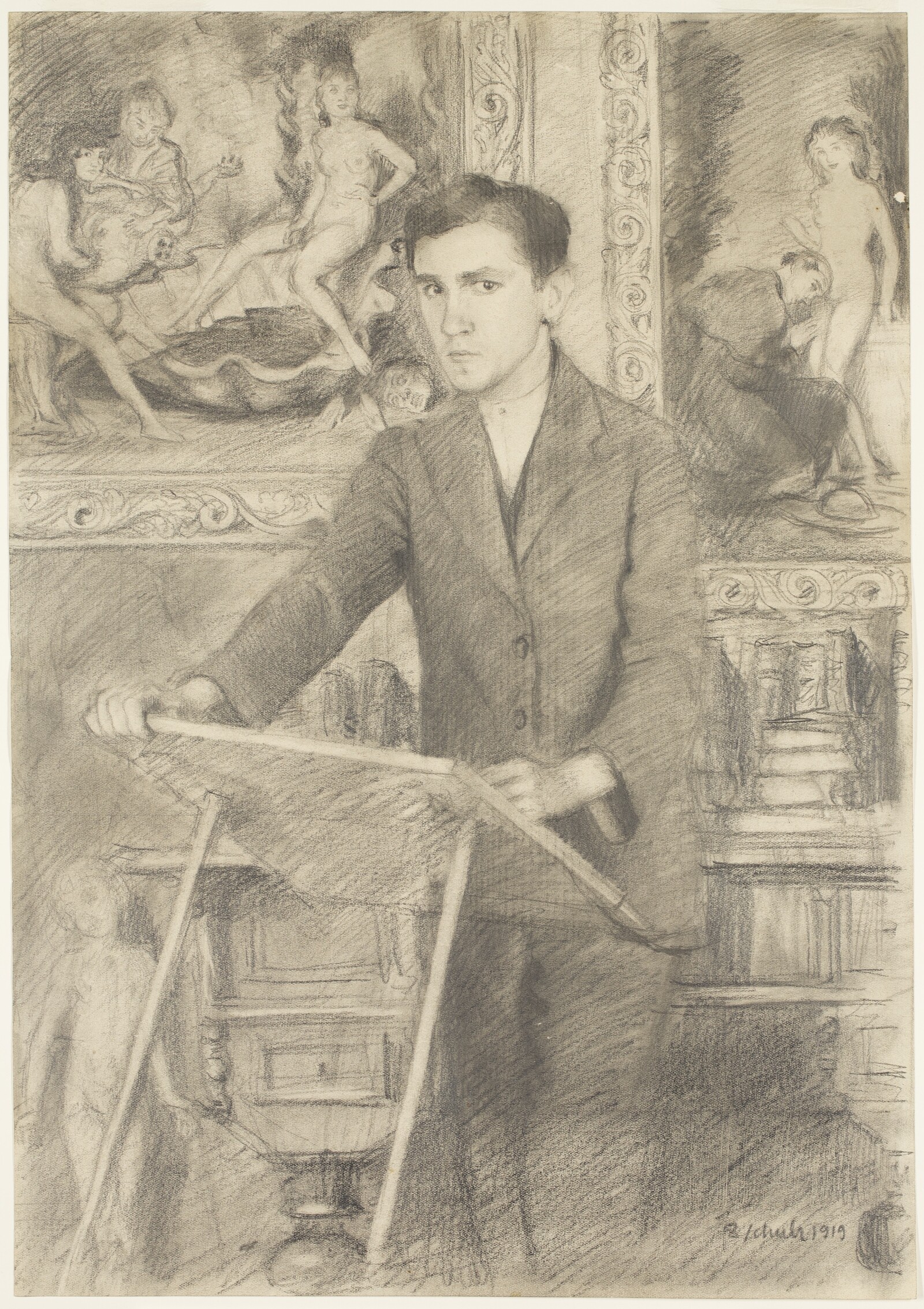In 1942, the Jewish-Polish artist and writer Bruno Schulz was murdered in the street by a Nazi officer. Though his weird and immersive short stories—many of which are set in his hometown Drohobych and in a dreamscape rendered after it—have lasted, most of his art perished with him.1 The small fragment of his visual oeuvre which survived the war has often been sensationalized, reduced to mere embodiments of the artist’s masochistic and fetishistic fantasies. Thankfully, here curator Jan Owczarek proposes a more nuanced take, setting Schulz’s work alongside that of contemporary artists who share his interest in forging personal, ambivalent mythologies.
The title of the show is sourced from an interview with the artist in which he suggests that artists tend to explore a limited number of subjects across their creative lives.2 The exhibition charts the handful of visual themes towards which Schulz leaned—genre scenes against a city background, or conversations set in tiny rooms—but his overarching subject, returned to obsessively, was the depiction of gendered power dynamics. The opening work—a 1919 self-portrait in pencil on paper—serves as a good example. Here, we see the artist, his gaze fixed on the beholder, leaning in front of a drawing board. The room he is in resembles a fanciful stage set, with a heavy bookshelf and compositions in ornamental frames in the background: one depicts naked women frolicking around a basin, while another shows a man in a clerical attire, bowing to a female figure. At a first glance, women—as addressees of male worship— seem all-powerful in Schulz’s realm. But we cannot forget that it is a man, the author in the foreground, who constructs this fantastic scenery.
Schulz’s art makes no attempt to be universal: his literary and visual imagination was directed inwards. Both stemmed from the same source, and revolved around the symbolic nucleus of the male/female binary. Schulz’s short stories—published as The Street of Crocodiles (1933) and Sanatorium Under the Sign of the Hourglass (1937)—were often interpreted as hypnagogic chronicles of a disintegrating cosmos, centered around the dying Father: a metaphor for order and reason. The women—humiliating and tyrannizing the male protagonists—were often understood as parodies of the Law, and illustrated the fall of the world Schulz held so dear.
The contemporary works selected for the show question and reverse this interpretation, imbuing the female element with agency. Next to a group of Schulz’s drawings depicting feeble males kneeling before frigid, domineering temptresses is Zuzanna Bartoszek’s Feet and Books (2022). The triptych’s first two segments show disembodied legs painted in a sketchy manner, while the last panel, all in crimson, shows a boy reading. It is up to the viewer to decide whether the child plays the role of the dreamer or the dreamed in this staging. Equally cryptic are the status and intentions of the female colossi in Aleksandra Waliszewska’s pastel Untitled (2021–22), manifesting before a male wanderer resting by a bonfire, or Katarzyna Kozyra’s photograph of her elaborate impersonation of the psychoanalyst Lou Andreas-Salomé, driving a carriage drawn by animal cosplayers masquerading as Rilke and Nietzsche (Lou Salomé Palais Schwarzenberg: Carriage, 2005).
Contemporary pieces are noticeably outnumbered by Schulz’s sketches, arranged in clusters following a non-rigorous classification, and yet the show is joined up by the inventive exhibition scenography of Emilia Kina and Bartek Buczek. The duo have managed to produce an elaborate and coherent parallel world, and as such, their design constitutes a significant (and elaborate) contribution to the exhibition. All the museum walls are decorated with schematic, trompe l’oeil curtains; additionally, the artists have designed intricate, wooden frames that allow some of the drawings to occupy a third dimension, such as the plywood decoration resembling a holy scroll adorning the frontispiece of Xięga Bałwochwalcza (The Booke of Idolatry, 1920–22), a rare collection of Schulz’s notorious cliché verres. Schulz used this challenging printing technique—which required sketching on a glass surface covered with dark varnish and pressing it against photosensitive paper—to produce a series of enigmatic scenes, heavy with erotic tension. One (The Pilgrims, 1920–22) shows a crowd of the author’s grotesque alter egos crawling in front of a frowning woman, pointing her blasé gaze someplace beyond the frame.
Schulz’s artistry diffuses a mesmerizing charm over the viewers. One cannot help but admire the finesse with which he captured subtle facial expressions, and the careful, yet purposeful, gestures of his microcosm’s inhabitants. Yet the drawings cannot be viewed today as a purely aesthetic phenomena: their elegance starkly contrasts with the horrific reality of Schulz’s death. Even though they are not here framed as such Schulz’s drawings stand as mute reminders of the gruesome consequences of wars past and present. But furthermore, the transgressive expressions of a private desire produced almost a hundred years ago still challenge the destructive patriarchal matrix reigning in Poland today.
Schulz the visual artist is rarely presented internationally due to the fragility of his surviving oeuvre. Contemporary art audiences might know him through a display of his frescoes—lent from the Drohobych City and Regional Museum, Ukraine—as part of Documenta 14 in 2017.
Stanisław Ignacy Witkiewicz, “An Interview with Bruno Schulz in the Tygodnik Ilustrowany,” (1935), in Bruno Schulz. The Iron Capital of the Spirit (Warsaw: The Adam Mickiewicz Museum of Literature, 2023), 25.





